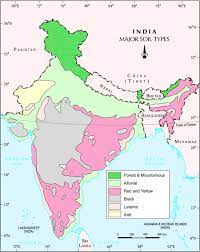Soil is a natural resource that plays a crucial role in supporting the growth of plants and maintaining the ecological balance. The classification and distribution of soils in India are important factors that affect the agricultural productivity of the country. In this article, we will discuss the various types of soils found in India and their distribution across the country.

Table of Contents
Classification of Soils in India
Soils in India are classified based on their physical and chemical properties, such as texture, structure, color, and nutrient content. The following are the major types of soils found in India:
- Alluvial Soils: These soils are formed by the deposit of silt, sand, and clay from rivers and are found mainly in the northern plains of India. Alluvial soils are rich in nutrients and are ideal for crops like rice, wheat, and sugarcane.
- Red and Laterite Soils: These soils are found in regions with high temperatures and heavy rainfall and are rich in iron and aluminum oxides. Red and laterite soils are mostly found in the eastern and western coastal regions of India.
- Black Soils: These soils are rich in organic matter and are known for their fertility. Black soils are mostly found in the Deccan Plateau and are ideal for growing cotton, soybean, and wheat.
- Arid and Desert Soils: These soils are found in areas with low rainfall and are mostly covered with sand. Arid and desert soils are mostly found in the western and northwestern regions of India.
- Mountainous Soils: These soils are found in the mountainous regions of India and are characterized by low fertility and shallow depth.
Distribution of Soils in India
Soils in India are distributed across the country based on various physical and climatic factors, such as temperature, rainfall, and altitude. The following is a brief overview of the distribution of soils in India:
- Alluvial soils are found in the northern plains of India, covering an area of about 40 million hectares. These soils are found in the states of Uttar Pradesh, Punjab, Haryana, and Bihar.
- Red and laterite soils are found in the eastern and western coastal regions of India, covering an area of about 15 million hectares. These soils are found in the states of Tamil Nadu, Kerala, Karnataka, and Maharashtra.
- Black soils are found in the Deccan Plateau, covering an area of about 8 million hectares. These soils are found in the states of Maharashtra, Madhya Pradesh, and Karnataka.
- Arid and desert soils are found in the western and northwestern regions of India, covering an area of about 25 million hectares. These soils are found in the states of Rajasthan, Gujarat, and Haryana.
- Mountainous soils are found in the hilly regions of India, covering an area of about 10 million hectares. These soils are found in the states of Himachal Pradesh, Uttarakhand, and Jammu & Kashmir.
Conclusion
Soils in India play a crucial role in determining the agricultural productivity of the country. Understanding the various types of soils and their distribution across the country is essential for sustainable agricultural development and ecological balance. By utilizing the right type of soil for a particular crop, farmers can increase their yields and contribute to the overall economic growth of the country.
Thanks for reading article on Classification and Distribution of Soils.
Important Links